The following research article is a transcript from a presentation made to Joint Forces Staff College faculty and students. The Editorial Board initially considered publishing the question and answer portion of the presentation, but decided that the content held significant value and should be published in its entirety. Over the next few weeks, Campaigning will publish Parts 2 and 3.
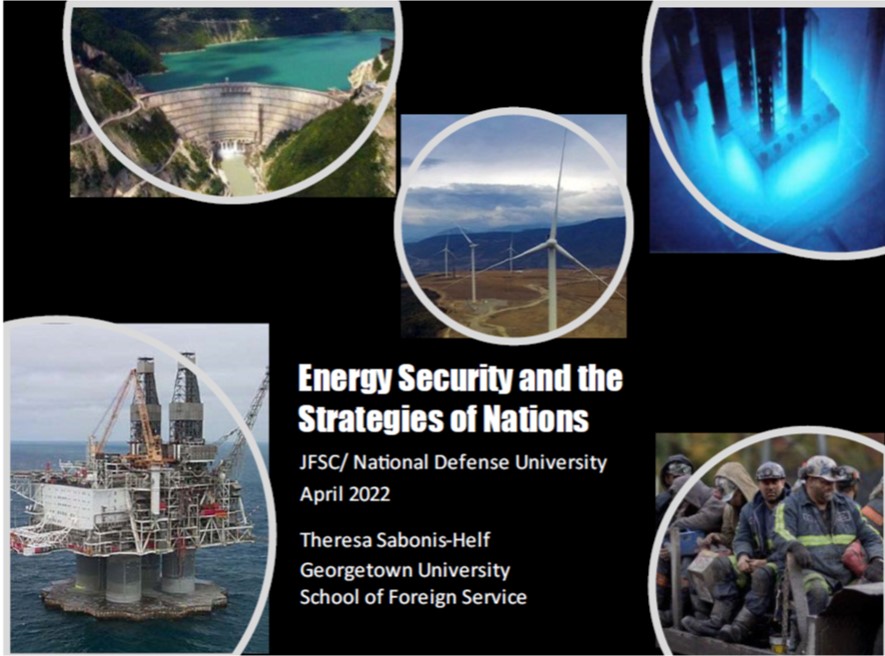
I'm going to make the case today that energy strategy is actually very deeply integrated into the overall strategy of nations, both importing and exporting nations. And I want to give you some examples about strategies in war, in crisis, and in peace. But since it's very much on everyone's mind right now, I want to begin with war in the Crimea, but I'm not going to begin with today. I'm going to begin with the Crimean situation eight years ago (refer to figure 1).
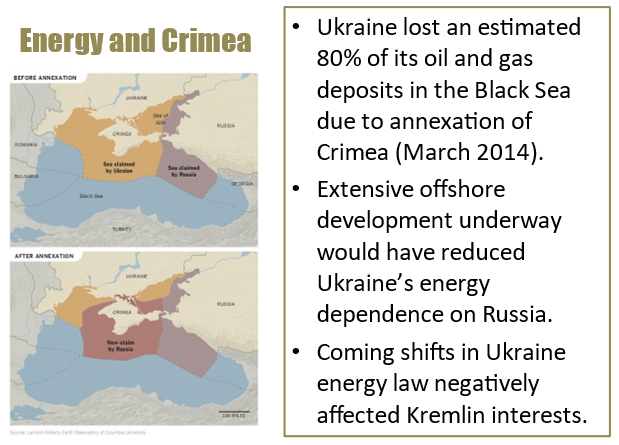
Figure 1. Energy and Crimea. Sources: Ariel Cohen, “As Russia Closes in on Crimea’s Energy Resources,” Forbes, February 28, 2019; Todd Prince, “After Years of Stalling, Can Ukraine Finally Become Energy Self-Sufficient?” RFE/RL September 15, 2019; map https://static.euromaidanpress.com/wp-content/uploads/2018/10/1.jpg from Lamont-Doherty Earth Observatory of Columbia University.
When we think about the war, the conflict between Russia and Ukraine, it's about much, much more than just energy. But I'm going to call your attention to the way that energy has played in this conflict over and over again on a number of different levels. Now, if you look at pre-2014, what we saw is that Ukraine had found some major offshore deposits around Crimea, and those offshore deposits would have, if when developed, significantly reduced Ukraine's energy dependence on Russia, and at the same time Ukraine was doing some substantial shifts in energy law that would have negatively affected the Kremlin's interests. Since the conflict, and since Crimea's declaration of allegiance to Russia, Ukraine has lost an estimated 80 percent of the oil and gas deposits in the Black Sea, which now cannot be developed commercially because of the contestation about whether that territory is in Ukraine’s offshore legal sphere or not (refer to figure 2).
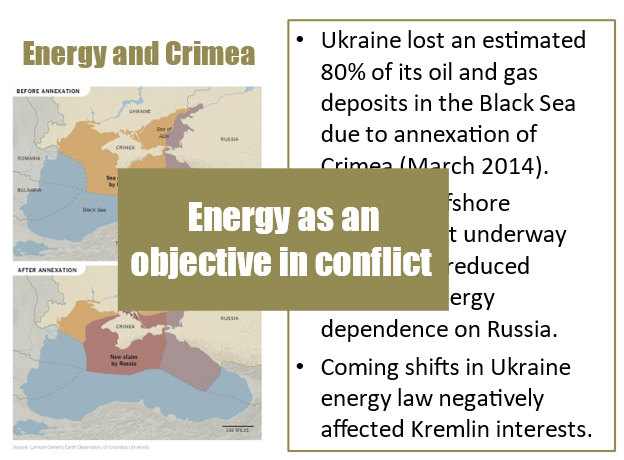
Figure 2. Energy as an objective in conflict. Sources: Ariel Cohen, “As Russia Closes in on Crimea’s Energy Resources,” Forbes, February 28, 2019; Todd Prince, “After Years of Stalling, Can Ukraine Finally Become Energy Self-Sufficient?” RFE/RL September 15, 2019; map https://static.euromaidanpress.com/wp-content/uploads/2018/10/1.jpg from Lamont-Doherty Earth Observatory of Columbia University.
So what we have to understand is that energy has served as an objective in the conflict, and although Russia did not succeed in changing the direction of Ukrainian energy law, it did succeed in limiting some of Ukraine's objectives, and it began to succeed in that area of energy as an objective very early on back in 2014. In terms of it being an objective, that's not the only way that energy has played into this conflict (refer to figure 3).
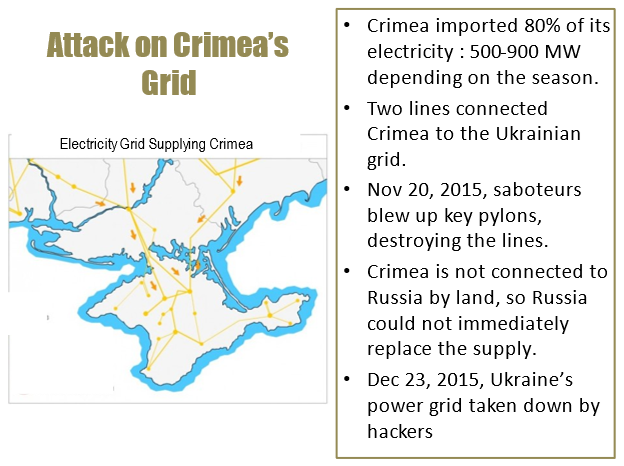
Figure 3. Attack on Crimea's Grid Source: Anna Shamanskaa, “Why Ukraine Supplies Electricity to Crimea, and Why it Stopped,” RFE/RL, November 24, 2015. Map from http://energysquared.files.wordpress.com/2014/03/powerdis.jpg.
It turns out that even after Crimea declared allegiance to the Russian Federation, they continued to rely on Ukraine for their electricity, and in fact, in the wintertime Crimea was importing 80 percent of its electricity from the mainland of Ukraine. Ukraine sort of let that go for almost a year but in November of 2015, saboteurs loyal to the Ukrainian government blew up two key pylons. If you look closely at that map, you can see two yellow trunk lines connecting Crimea to the mainland. Those were destroyed, and although Ukraine did not claim credit for the attack, they also moved very, very slowly to restore the lines after the attack. In the end they never did restore the lines. What you saw is that in November 2015, Crimea was plunged into darkness, and that was a hard problem to remediate because they had no land or no power connections to Russia. They didn't have very extensive generation capacity on the peninsula, and so it was a serious blow to the citizens of Crimea in the winter of 2015. It was a very cold and very dark winter. It was in the context of that physical attack on Crimean energy infrastructure that the next thing happened (refer to figure 4).

Figure 4 Attacks on the Ukraine Grid. Source: Global Energy Network Institute, Attacks on the Ukraine Grid. Map from http://www.geni.org/globalenergy/library/national_energy_grid/ukraine/ukrainiannationalelectricitygrid.shtml
In December of that same year, Ukraine became the first country in the world to have a cyberattack take down a portion of its power grid. A month after Crimea had gone offline, a cyberattack took thirty substations offline in Ukraine, leaving a quarter million of its residents without power. Ukraine was able to restore the grid within six hours, but many of the substations were not fully operational for several months, and it did do some significant damage to the integrity of the infrastructure. Almost precisely a year later, we saw a second cyberattack that brought down a larger chunk of the grid than the first one had. It was restored very, very quickly, but forensics after the fact discovered that the second attack had actually partially failed. It was a much more ambitious cyberattack designed to do substantial damage to the grid upon restart, and the Russians were unsuccessful in that second part of their attack (refer to figure 5).
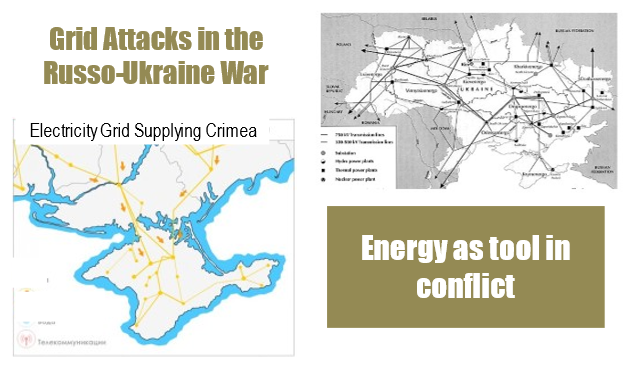
Figure 5. Grid Attacks in the Russo-Ukraine War. Sources: Anna Shamanskaa, “Why Ukraine Supplies Electricity to Crimea, and Why it Stopped,” RFE/RL, November 24, 2015. Maps from https://energysquared.files.wordpress.com/2014/03/powerdis.jpg and http://www.geni.org/globalenergy/library/national_energy_grid/ukraine/ukrainiannationalelectricitygrid.shtml.
This calls to our attention the fact that energy has been a tool in this conflict for a number of years now on both sides, and that that has actually been a characteristic of the conflict (refer to figure 6).
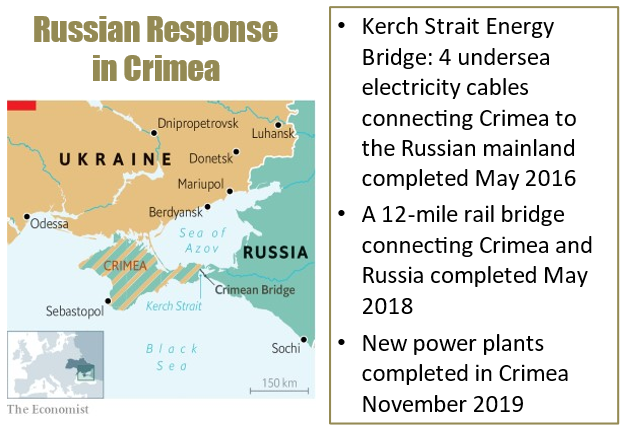
Figure 6. Russian Response in Crimea. Source: Tass, “Crimea will be able to export electricity, first time ever,” November 22, 2019 and Lyrchikova and Zverev, “Sanctions short-circuited Russia’s electricity plans for annexed Crimea, Reuters, April 27, 2017. The Economist, Map found at https://www.economist.com/europe/2021/06/24/russian-and-british-forces-square-off-in-the-black-sea
This of course brings us to a third point and a point that's going to be really important in the rest of my presentation. If you look at the Crimean Peninsula, what you will find is that within six months of that winter electricity crisis, even though Russia was already being sanctioned, even though Russia was facing some significant financial constraints, Russia, at a very high rate of speed, completed the electricity connections to put Crimea onto the Russia electricity grid. That undersea connection ensured that Crimea would never again have that kind of cold dark winter that they experienced in 2015, 2016, and in addition, Russia financed the construction of new power plants in Crimea so that Crimea is now a net exporter of electricity to the Russian grid (refer to figure 7).
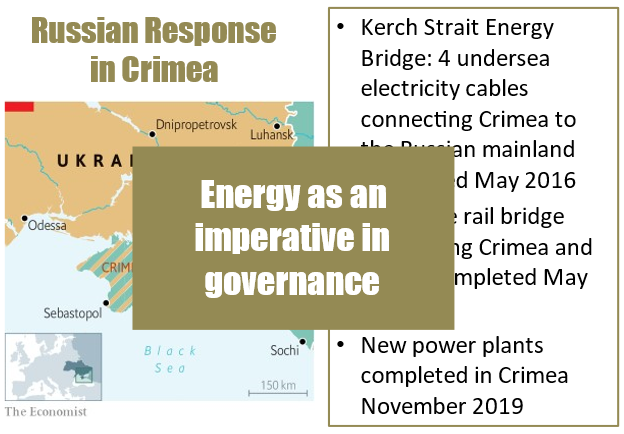
Figure 7. Energy as an imperative in governance. Map found at https://www.economist.com/europe/2021/06/24/russian-and-british-forces-square-off-in-the-black-sea
This is important. From the Russian perspective, they recognize that energy is an imperative in governance. If you have a society that is highly urbanized in a cold climate accustomed to electricity, light, and heat, you cannot retain control over that territory if you can't get the lights on. Russia recognized that among its many competing objectives, even objectives on the mainland of Russia, getting the lights on in Crimea was an absolute imperative. This point that energy is a governance imperative is going to continue to be our focus (refer to figure 8).
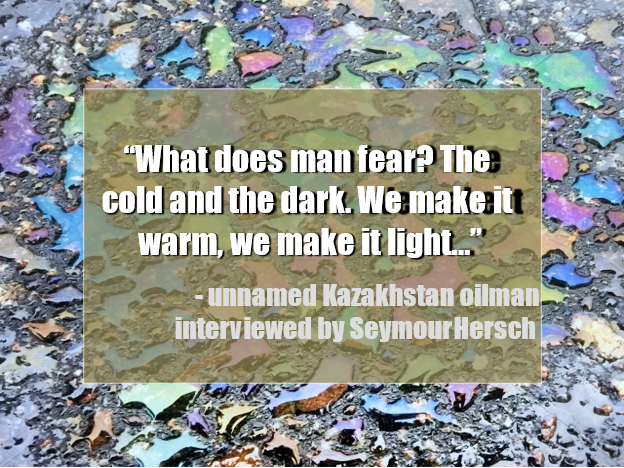
Figure 8. What does man fear? Source: Seymour Hersch unpublished interview of unnamed Kazakhstan oilman. Source: The New Yorker, Seymour Hersh, 1 July 2001 found at newyorker.com/magazine/2001/07/09/the-price-of-oil
Because mankind fears the cold and the dark, making it warm, making it light, is part of the social contract. The World Bank actually uses electrification as a definitional criterion of being a developed state. So in other words, if you want to meet the World Bank definition of being a developed state, you have to demonstrate that you can reliably keep the lights on to more than 95 percent of your territory. So reliable access to electricity is actually part of the criteria of being a developed state, and this illustrates further that close association between regime security and energy security. Alright, let's turn now to looking at energy security and peace time (refer to figure 9).

Figure 9. China's Electrification. Sources from EIA China Country Report, Generation data from IEA Key World Energy Statistics 2020, electrification information from He Gang, “Three lessons from China’s effort to bring electricity to 1.4 billion people.” China Dialogue, July 24, 2017.: Graphic from https://www.eia.gov/international/analysis/country/CHN
In China, the Chinese Communist Party viewed getting the lights on and keeping them on as a critical demonstration of capability. So even though already in 1990 China was able to supply electricity to about 97 percent of its population, they announced the “electricity for all” plan in 2012 to reach that final group of people to achieve full electrification, and they declared success in 2015. Accomplishing this required development of really ambitious transmission systems, reaching further and further into rural areas and into mountainous areas. It also required ramping up generation of electricity from all available sources. China is very rich in both coal and in water, so it's not surprising that China leads the world in exploitation of hydropower and coal. But what you need to understand, and maybe this will strike you as more surprising, China also leads the world in renewable energy in solar and in wind generation. This has been a challenge in a couple of different ways (refer to figure 10).
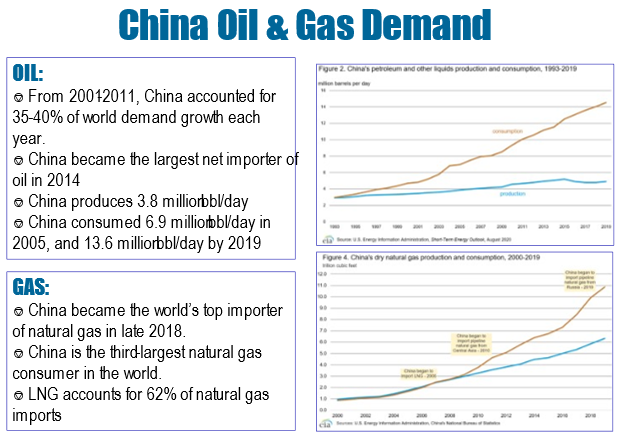
Figure 10. China Oil & Gas Demand. Source: Consumption graphics from EIA Country Report at: https://www.eia.gov/international/analysis/country/CHN. Report and graphics from https://www.eia.gov/international/analysis/country/CHN
What you see here is these remarkable increases in oil and gas demand. Remember, during this time period China is not only electrifying, China is also doing all kinds of things, increasing the pace of its economy, and making the economy much more energy intensive. If we look at oil, what we see is a profound shift in oil policy for China. Prior to 2001, China had a pretty hard-core oil security policy, and the policy was if you wanted oil, if you want to use oil in China, you had to find it in China or it had to be Chinese-financed development from abroad. China is actually in the top five producers of oil. But that policy had to be retired in 2001 because China joined the World Trade Organization, and you can't be a member of the World Trade Organization if you refuse to trade in the world's most traded commodity. So as soon as China began to relax the rules on imports of oil, what you see is that incredibly fast takeoff in demand, and what we see is that China went from importing very little to become the largest net importer of oil in the world in a very short period of time. That continues to unfold, and what we see is that it's true not only in oil but also in gas. When you look at the gas chart, what you see is that China produces or has more production capability in natural gas than they do in oil, but still, once again that demand skyrocketed remarkably in a fairly short period of time with China becoming the third largest consumer in the world of natural gas and the largest importer of natural gas, all in a short period of time. So if you think about this, China's dramatically importing in a rapid period of time, what's the natural consequence of that (refer to figure 11)?
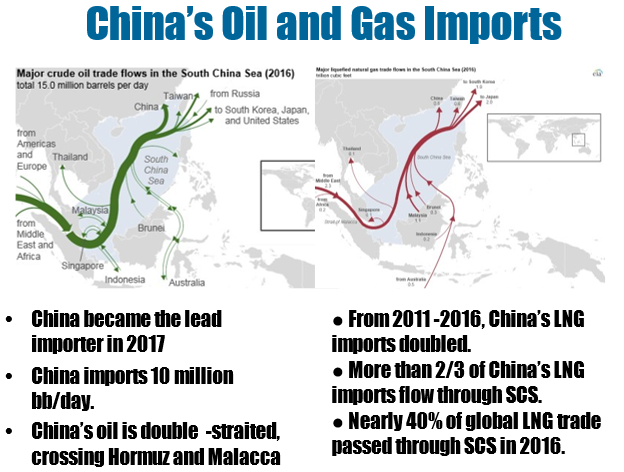
Figure 11. China Oil & Gas Imports. Source: information and graphics from https://www.eia.gov/international/analysis/regions-of-interest/South_China_Sea
China gets pushed further and further into the sea lanes, and as China has pushed into the sea lanes, as the pressure builds on those sea lanes, China gets much more interested in both international relations issues that had not been of interest before and defending the straits. What you see is that as China's dependence for energy grows, they feel more and more compelled to beef up the navy. China also discovers a real aversion to sanctions because so many of the countries from which China imports oil and gas were subject to sanctions—Iran, Sudan, Venezuela, Somalia. What we see is that China experiences these new and troubling vulnerabilities because of the sea lanes, and this of course pushes China in yet a new direction (refer to figure 12).
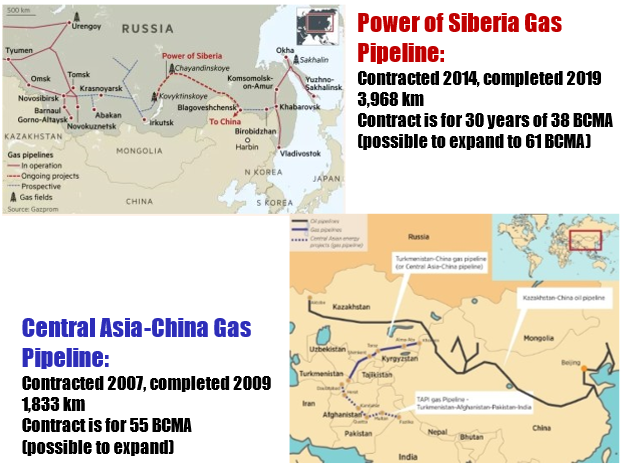
Figure 12. Power of Siberia Gas Pipeline and Central Asia-China Gas Pipeline. Source: top graphic from Gazprom found in Financial Times https://www.ft.com/content/623c7396-60cc-11e7-91a7-502f7ee26895 bottom graphic from Russia Direct, Natalia Mikhaylenko, Energy infrastructure in Central Asia, https://russia-direct.org/analysis/china-russia-and-new-great-game-central-asia
Before its announcement of the Belt and Road Initiative, China actually very dramatically built out new infrastructure. The Central Asia China Gas pipeline, which is now spoken of as if it's part of the Belt and Road Initiative, actually preceded the Belt and Road Initiative and created the longest overland pipeline supply in the world to try to diversify China's risk so that it wouldn't all be in the sea lanes. What we see is that China, at the same time it was reinforcing those sea lanes, it was building overland pipelines, and the Central Asia China gas pipeline was followed by the Power of Siberia pipeline, which was actually even longer than the Central Asia China gas pipeline. China has been expanding dramatically in all these different directions to try to meet and address the supply risks associated with its growing dependence on energy. But supply risk wasn't the only challenge that China was facing (refer to figure 13).
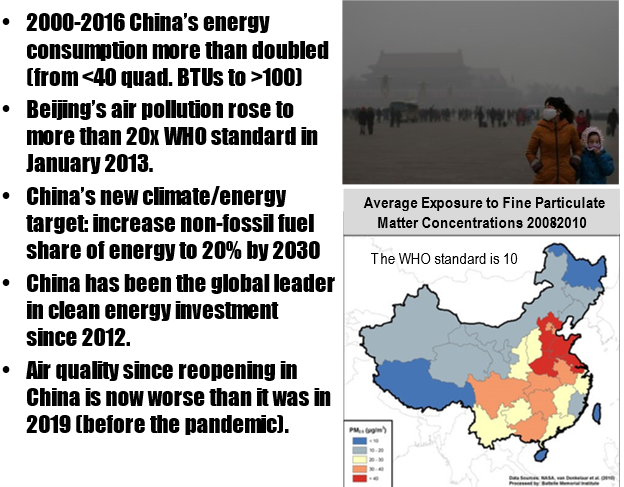
Figure 13. China's energy consumption and air quality. Source: Map from NASA and Battelle Memorial Institute. Source: top graphic Steven Jiang, CNN, photo by Feng Li, Getty Images, tourist and her daughter wearing masks visit to Tiananmen Square, https://www.cnn.com/2015/03/02/asia/china-smog-documentary/index.html, bottom map NASA, von Donkelaar et. al. (2010) processed by Battelle Memorial Institute, Average exposure to fine particulate matter concentrations (PM 2.5) 2008-2010, found at Columbia University https://news.climate.columbia.edu/2012/03/07/bottom-up-or-top-down-another-way-to-look-at-an-air-quality-problem/
While energy consumption exploded, more than doubling in less than fifteen years, we saw pollution levels that exploded dramatically as well. What we see is that China now experiences pollution that exceeds the World Health Organization's maximum by up to twenty times in some years and frequently in winters. China was facing a new constraint: public health problems and popular perception problems. These pushed China to become the global leader in clean energy. But what you should understand is that China continues to prize “more” over “cleaner,” and when China reopened as a consequence of trying to recover from the pandemic, it actually relaxed air quality standards. Up until a month ago when they began shutting down major cities, we saw that air quality in China this past winter was worse than it was in 2019 before the pandemic. But there is undeniably a green component to Chinese energy (refer to figure 14).
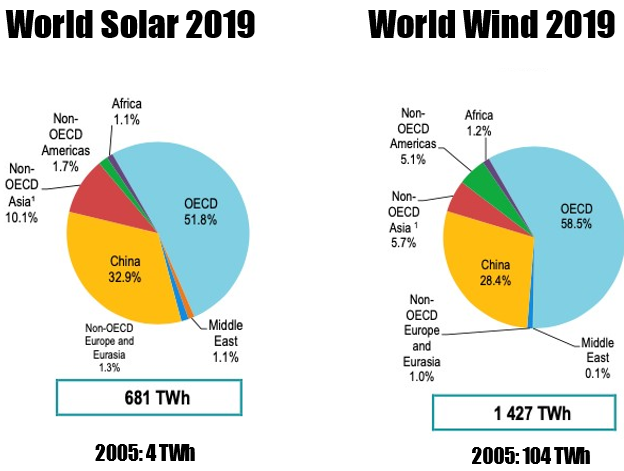
Figure 14. World Solar and Wind 2019. Source: Images & Data from IEA Key World Energy Statistics 2021. Source: https://iea.blob.core.windows.net/assets/52f66a88-0b63-4ad2-94a5-29d36e864b82/KeyWorldEnergyStatistics2021.pdf, p. 22 and 24
What we see here is that China leads the world in wind. China leads the world in solar. China is investing enormously in these technologies, and this is logical for a resource-scarce growing country. China is also leading the world in nuclear construction and development. The Chinese case reminds us that even in peacetime, a state probably will have to continue innovating to keep the lights on—that it becomes an important component of strategy, affecting a lot of other strategy, to try to think about keeping the lights on (refer to figure 15).
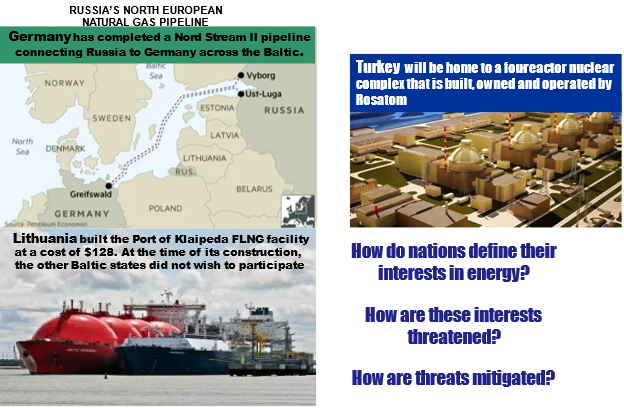
Figure 15. Russia's north European natural gas pipeline, Lithuania's FLNG port facility, and Turkey's four-reactor nuclear complex Sources: top left Financial Times, https://www.ft.com/content/e9894b38-095d-11e7-ac5a-903b21361b43, bottom left Image from Hoegh LNG, found at https://www.offshore-energy.biz/lithuanian-terminal-receives-50th-lng-cargo/, right image Rosatom rendition of Akkuyu Nuclear Power Plant found at https://bellona.org/news/nuclear-issues/2018-04-russia-says-it-can-pay-for-turkeys-first-nuclear-plant-by-itself
Because nations have to continue innovating, they often make choices that trouble their neighbors. If you look at European energy, we see a whole series of issues where one nation made a strategic choice that either perplexed or made unhappy their neighbors. Nord Stream II has been so much in the news, I don't even need to talk about it much. Germany made the calculus that directly trading with Russia would reduce some of the frictions associated with Russia's relations with the transit states. This caused anxiety and discontent among many European states. And of course, at the present time, although Nord Stream II is completed, Germany has not opened it. They are still using Nord Stream I, which follows the same route. Let's look at two cases that are probably less well known.
The Turkish case is that in 2010, Turkey signed an agreement with Russia to have Russia build, own, and operate for the lifetime of the reactors four nuclear power plants on the territory of Turkey. The construction of that is well under way. The first one of those is scheduled to come online in 2023. For European states, that new kind of reliance and actually having Russia own a strategic object on their territory caused a lot of concern in NATO and in Europe, but from the Turkish perspective, they are relatively energy scarce. They have the fastest growing demand for electricity in the European Community, actually in the OECD, and diversifying their portfolio into nuclear seemed to be a very rational choice. Turkey had been unable to pull together the financing for many years, and Russia offered to finance it. From the Turkish perspective, given the way they define their chief concerns, it made a lot of sense.
Now if you look at the lower left-hand corner, you see Lithuania. This is a case of something that didn't seem to make sense at the time to many people, that now seems to be strategically quite clever. In 2012, Lithuania announced that they were going to build a floating LNG facility right off their coast, and they warned their people that this would cause both electricity and gas prices to more than double. It was enormously unpopular domestically, because doubling energy prices gets people very upset as you can think of from our American experience currently. But the Lithuanian government moved ahead and said, look, even if Russia offers us a discount, we're going to continue to pursue this route. They turned to their neighbors and they said, hey, Latvia, Estonia, would you be interested in becoming a part of this? And the Latvians and the Estonians saw the domestic dissatisfaction and said, no, no, no, no, not interested. So Lithuania persisted, completed the construction on their own, in spite of some domestic lack of interest in doing so. They completed the facility right about the same time that Russia invaded the Donbas. So suddenly Lithuania looked very clever. As you can see in each of these cases, there's a disagreement about what's the most important threat and what's the most important interest. Part of the reason for that is when we look at energy security, we have to think about what are the components of energy security (refer to figure 16).
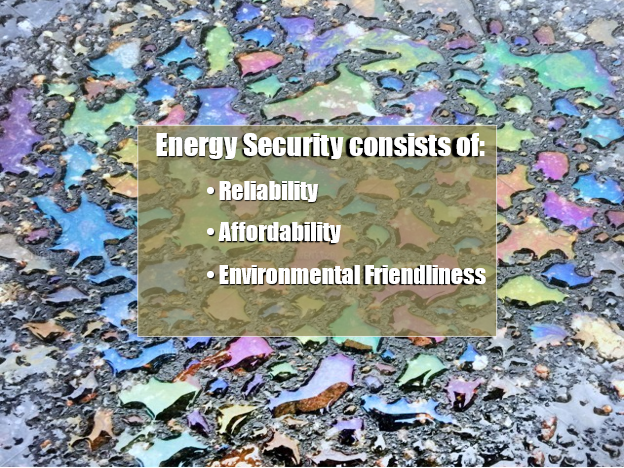
Figure 16. Energy Security Trilemma. Source: International Energy Agency, found at https://www.worldenergy.org/transition-toolkit/world-energy-trilemma-index
Energy security does have a definition to which we all subscribe by treaty, the European states and the United States. We say that energy security consists of reliability, affordability, and environmental friendliness. You might look at that list of three and think those are great values—I want more of all of those. Given the current state of technology, you cannot have more of all of those. This is in fact a trilemma. The more you maximize one of these, the more you're going to take a hit in another one of these. What ends up happening is states tend to fix on one of these three, maximize for that, and then they have to readjust policy when they recognize that the three-legged stool has gotten badly out of balance. Think about it. The quest for reliability, getting enough energy, led China further and further into the sea lanes. Awareness of environmental problems led them toward new technologies. Turkey's effort to try to make energy in Turkey more affordable and reliable may actually have created risks or additional risks for Europe due to its dependence. This is very complex. It has to be continually rebalanced, and it's very controversial how a nation should think about this (refer to figure 17).

Figure 17. Daniel Yergin's fourth dimension to energy security. Source: Daniel Yergin, “Energy Security in the 1990s,” Foreign Affairs, Col 67 No. 1, 1988, page 111, found at https://www.foreignaffairs.com/articles/united-states/1988-09-01/energy-security-1990s
To make things even more complicated, one of our leading energy scholars in America argues that there's actually a fourth component—that trying to reduce dependence on sources that threaten the state or its values has to also be factored in separately, not just in terms of reliability, but also in terms of thinking about how to make sure that what we do in energy doesn't undermine other things that the state cares about. When Dan Yergin proposed this way of thinking about it, he really focused on, are we importing energy from bad actors? But there are other arguments connected to Yergin's concern. For example, if you allow a high level of corruption in the energy sector, and that degrades the state or its values—is that a high strategic priority? Many Europeans argue that it has long been and we're now finally starting to recognize it. You have to ask the question, if you're using a resource that not only damages immediate environmental friendliness, but that actually poses threats to the planet—do you have to rethink that? Many other European states are arguing that climate change fits into this fourth category—that it actually threatens the state and its values.
The views expressed are those of the author(s) and do not reflect the official policy or position of Joint Forces Staff College, National Defense University, the Department of Defense, or the U.S. Government.
 Download the PDF version: Part 1
Download the PDF version: Part 1